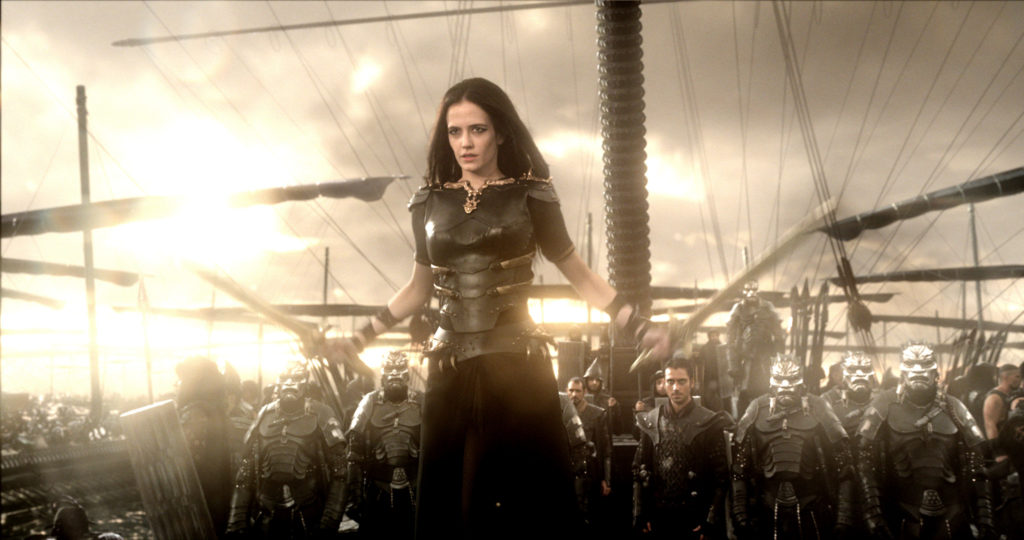300: Rise of an Empire (2014)

Readers who’ve seen my review of Zack Snyder’s 300 won’t be surprised to learn that its prequel/sequel, 300: Rise of an Empire, doesn’t meet well with me. It’s more of the same poorly scripted, intensely jacked-up, copiously bloody, viciously snarling, and consummately empty war tale that replaces character nuance and necessary exposition for macho posturing and slow-motion, green-screened imagery.
As with its predecessor, it is reportedly based on Frank Miller graphic novel; although that claim is dubious given that the comic book had not only not been released before start of the film’s production, the comic book author only had 40% of it done at the time the movie first saw a theater screen (and it still hasn’t been printed as of this writing). That part is the true shame of this limp-as-a-noodle sequel, as the best part of Snyder’s original epic came through his attempt to recreate the imagery of Miller’s pencils in a live-motion format. This sequel certainly has the imagery, but rather than lifting from the vision of Miller; it merely regurgitates the same shots from 300. It’s in the slavish adherence to the Snyder visual opus that Rise of an Empire fails, unable to get out of the box of utterly predictable style-first flair.
The events of 300: Rise of an Empire are mostly set before that of 300, though parts of it are concurrent, and also continues further in the timeline. In contrast to its predecessor, which was, by its nature, land-locked, this second take changes the locale to digitally-crafted ocean warfare between the ragtag Greeks and the unified Persians. Despite the new setting, most of the violence comes from hand-to-hand combat, with a level of computer-generated blood that is so fake-looking and ridiculously splashy that it renders the attempt at ultraviolence feeling cartoonish and ineffectual. One could almost hear Snyder yelling in post-production, “We need more blood! More blood! We’re going to post convert to 3D, so make it splash across the screen, even if it’s from a paper cut!” And there are plenty of neck wounds and beheadings, so much so that they soon lose any power after you’ve seen the first instance; if you can’t feel a thing for the victim when his head is completely severed from his body, it’s a sure sign that you’re probably watching a movie that has little to no investment in characters or story.
In this film, we get the origin of Xerxes (Santoro), son of the Persian king Darius (Naor), who transforms into a god among rulers during an ancient ceremony, vowing to wipe out the Greek armies in revenge for the killing of his father in battle (lest we may have forgotten, his death is repeated later in the film). The man who killed him is Themistokles (Stapleton), a fierce Athenian general who is commanding a small fleet of boats against the overwhelming might of the Persian navy at the behest of Queen Gorgo of Sparta (Headey). Matching up against them is a ruthlessly wicked Greek woman fully allied now with Persia, Artemisia (Green), who plans to beat the Athenians into obsolescence, but hoping they will submit rather than continue to fight.
Rise of an Empire sees director Noam Murro replace Zack Snyder, who has kept himself involved by continuing to co-script, along with Kurt Johnstad, as well as producing. Anyone who has seen Sucker Punch will know that Snyder should never be allowed anywhere near a keyboard, as his dialogue and script ideas feel like they’ve been culled together from a think tank of middle school-aged boys. Murro has no prior experience with action flicks, with his only directorial outing coming six years prior with the mediocre dramedy, Smart People. But Murro really could be anyone, as he has Snyder’s slo-mo, washed-out visual style to copy from, as well as the man himself on hand throughout the entire filmmaking process. If nothing else, it does look and feel like 300, for better or worse.
Even if it does manage to keep the look and overall vibe of the first entry, I don’t think a film with this much envelope-pushing sex, violence, and the action should be as disengaging as it is. As much as Murro and Snyder crank up the volume to eleven, about 90% of the film is a mere spectacle, neither pushing the plot forward nor giving us something new or different to follow. Every once in awhile, something of interest will emerge for a moment. Perhaps the most riveting happens to be a sex scene between two of the characters that end up being treated as if it were an actual fight scene, with each participant doing what he/she can to gain the dominant hand. Unfortunately, without investment in these characters, it’s merely prurient sexual politics on display without any importance other than it breaks up the monotony of sameness that permeates the rest of the movie.
If 300: Rise of an Empire were the setting of a combat-based video game, it probably would fit much more neatly, given its adherence to visible computer graphics and forced boss battles of increasing difficulty. It also relies on “cut scene”-esque voice-over narration to prepare us for each impending arena battle. For people looking for just an orgy of blood, noise, and snarling faces on well-toned bodies, you’ll find these here in abundance. For people coming in searching for a good, or at least coherent movie, 300: Rise of an Empire has little but superficial aesthetics to beat its chest and shout about.
Qwipster’s rating: D+
MPAA Rated: R for strong sustained sequences of stylized bloody violence throughout, a sex scene, nudity, and some language
Running Time: 102 min.
Cast: Sullivan Stapleton, Eva Green, Lena Headey, Rodrigo Santoro, Hans Matheson, Callan Mulvey, David Wenham, Jack O’Connell, Andrew Tiernan, Igal Naor
Director: Noam Murro
Screenplay: Zack Snyder, Kurt Johnstad (based on the graphic novel, “Xerxes,” by Frank Miller)
